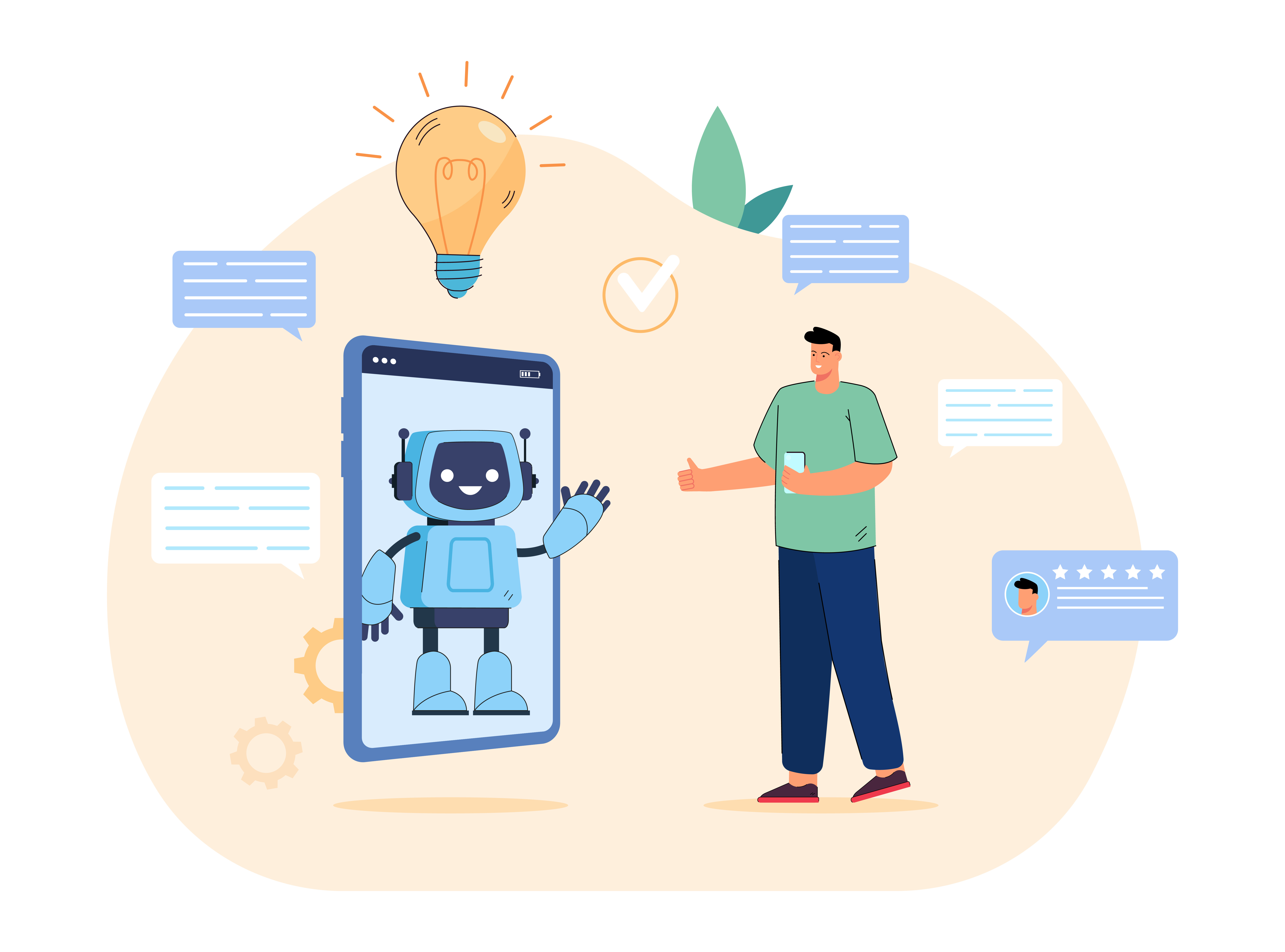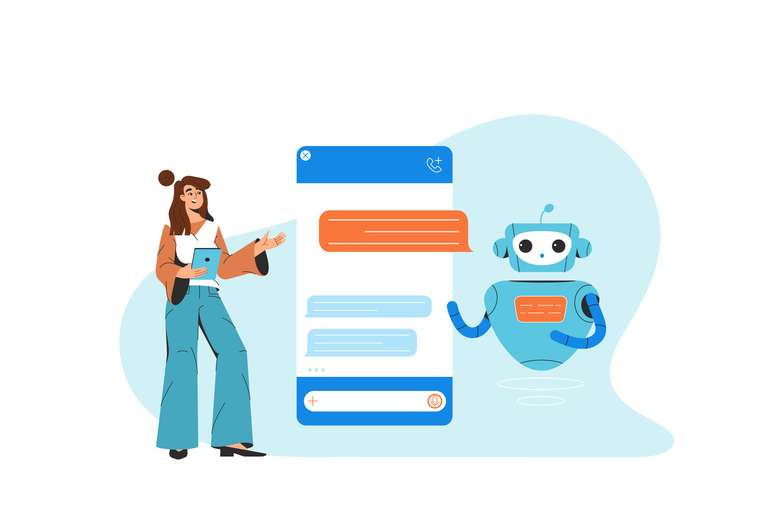Conversational AI: Applications,Benefits, and Future

Want to stimulate human conversations at lower costs? Conversational AI is for you. This intelligent technology leverages artificial intelligence (AI) to mimic human interactions. It is as simple as that.
This is possible owing to natural language processing (NLP), an area of artificial intelligence that enables computers to comprehend—and process—human language. NLP analyzes the meaning of speech and text to provide acceptable and contextual responses to the conversation.
In everyday applications, examples of conversational AI include chatbots and virtual assistants. Due to its widespread use cases and easy, scalable implementation, conversational AI is growing in popularity. A recent study claims that the "conversational AI market is estimated to grow at a CAGR of 23.4%, peaking USD 29.9 billion in revenues by 2028-end."
Table of Contents
How Does Conversational AI Work?
While most people have heard of conversational AI, few understand it. Here's a layperson explanation of what is conversational AI and its key components:
The first thing you need to understand is that conversational AI is generally trained on large data sets (think: text or speech). This 'data' basically helps the AI to learn how to analyze and process human language.
Plus, to be effective, conversational AI combines both natural language processing and machine learning.
Machine Learning: It is a sub-field of artificial intelligence. ML comprises thousands of algorithms, features, and data sets that work towards improving themselves continuously. The more the AI platform machine receives inputs, the better it gets at identifying patterns and making predictions.
NLP: This technology helps analyze language with the help of machine learning. Prior to machine learning, language processing methodologies were statistical in nature. Going forward, deep learning will transform the NLP capabilities of conversational AI.
Here's how conversational AI works:
Step 1: Input Generation
You provide input via a website or an app. Note that this format can be either text or voice.
Step 2: Input Analysis
If your input is text-based, conversational AI will use natural language understanding (NLU) to comprehend the meaning and extract the intention. And if the input is voice-based, it will use automatic speech recognition (ASR) and NLU to analyze the data.
Step 3: Output Generation
Once the AI deciphers the input, it will formulate a response using natural language generation (NLG), an integral component of NLP.
Step 4: Reinforcement Learning
Finally, the underlying machine learning algorithms will continue to refine their responses over time as it learns. The systems are in a state of constant feedback loop, trying to process, analyze, and generate accurate responses in an organic way.
Conversational AI Applications: At A Glance
Ask the experts, and they'll tell you about how conversational AI is categorized into weak (read: narrower) AI (such as chatbots and virtual assistants) and strong (read: AI with human-like consciousness) AI. The latter, of course, is still a theoretical concept.
The conversational artificial intelligence we experience today is restricted in its capabilities. It cannot think, problem-solve, or decide as humans do yet. However, even in its limited form, it is empowering a host of sectors to improve their productivity and scale their operations:
Customer Service
One area where conversational AI excels is in providing online customer service:
Chatbots: Chatbots and virtual assistants are actively being used to address customer FAQs, offer them hyper-personalized suggestions, cross-sell or upsell products, provide instant feedback, and more.
Natural language understanding: Conversational AI systems can also interpret and understand natural language inputs from customers, enabling them to have more natural and meaningful interactions. This helps in resolving customer queries accurately and efficiently.
Voice Assistants: Voice-based conversational AI tools, such as virtual assistants or voice-activated chatbots, can provide hands-free customer support. Customers can use voice commands to seek information, report issues, or receive assistance, making it convenient and accessible.
eCommerce organizations, for instance, are greatly benefiting from chatbots as human agents are redirecting their energies toward creative tasks.
Healthcare
Conversational AI is revolutionizing healthcare by providing personalized and accessible medical support:
Virtual healthcare assistants: AI-powered chatbots can interact with patients, gather symptoms, provide basic medical advice, and offer recommendations for further action.
Appointment scheduling: Conversational AI can handle appointment bookings, reminders, and rescheduling, saving time and resources for both healthcare providers and patients.
Remote patient monitoring: Conversational agents can collect health-related data from patients, such as vital signs or medication adherence, and provide real-time feedback to healthcare professionals.
Education
One of the foremost conversational AI applications is occurring in education as these tools are enhancing the learning experience and providing personalized support for students and educators:
Intelligent tutoring systems: AI-powered virtual tutors can provide personalized learning experiences, adapt to individual student needs, and offer feedback and assistance.
Language learning: Conversational AI technology can simulate real-life conversations, helping language learners practice speaking and improve their fluency.
Academic support: AI chatbots can assist students with homework, answer questions, provide explanations, and offer learning resources.
Voice Assistants
Another area where conversational AI is making its mark is voice assistants (think: Siri, Alexa, and Google Assistant). These assistants offer a wide range of applications:
Information retrieval: Voice assistants can answer questions, provide weather updates, deliver news, and perform internet searches.
Smart home control: AI-powered voice assistants can control smart devices, adjust lighting, regulate temperature, and perform various tasks within a connected home.
Entertainment and media: Voice assistants can play music, recommend movies or TV shows, and provide hands-free control over media playback.
Computer Software
Conversational AI has also found applications in computer software, enhancing user experiences and enabling more natural interactions:
Voice-controlled software interfaces: Text to speech (TTS) technology allows software applications to provide audible feedback or read out textual information, making them more accessible for users with visual impairments or those who prefer voice-based interactions.
Speech-to-text input: Speech recognition software enables users to dictate text, transforming spoken words into written text. This feature is valuable in word-processing applications, note-taking tools, and any scenario where keyboard input may be challenging or inconvenient.
Virtual assistants for software: Conversational AI-powered virtual assistants, integrated into software applications, can perform tasks based on voice commands. They can execute commands, provide guidance, and offer contextual help to users.
Accessibility
Conversational AI is also playing a crucial role in making technology more accessible for individuals with disabilities:
Speech to text and text to speech: AI-powered systems can convert spoken language to written text and vice versa, enabling communication for individuals with hearing or speech impairments.
Vision assistance: Conversational AI can describe visual content, such as images or videos, to individuals with visual impairments.
Navigation and mobility aids: AI-powered assistants can provide directions, assist with navigation, and help visually impaired individuals move independently.
Advantages Of Conversational AI
1. Personalization
One of the key advantages of conversational AI lies in its ability to provide a personalized touch. By leveraging data and user profiles, it can delve into customers' preferences, purchase history, and browsing behavior, allowing for tailored responses and recommendations.
2. Cost-Effective
Another compelling aspect is its cost-effectiveness. When compared to the expenses associated with hiring and training a large customer support team, implementing conversational AI proves to be a more economical solution.
Once deployed, it can efficiently handle a substantial volume of inquiries simultaneously, reducing the need for additional human agents.
3. Availability 24/7
Conversational AI systems are available around the clock. Unlike human agents bound by limited working hours, conversational AI tirelessly provides customer support and assistance at any time of the day or night.
This unwavering availability ensures that customers can obtain the support and information they need whenever they require it, irrespective of time zones or traditional business hours.
4. Increased Efficiency
Efficiency is a fundamental benefit that conversational AI brings to the table. Processing and responding to inquiries instantly drastically reduces response times and eliminates the need for customers to endure long waiting periods for human assistance.
Additionally, it automates routine tasks, liberating human agents to concentrate on more intricate, specialized matters.
Top Four Challenges and Limitations of Conversational AI
1. Integration With Existing Systems
Fitting conversational AI into existing infrastructure can be a challenge. Connecting to legacy systems with different data formats and protocols is a complex task that requires developers to invest time and effort.
2. Security and Privacy Concerns
Conversational AI raises concerns regarding the security and privacy of user data, as sensitive information might be shared during conversations. Protecting data from unauthorized access and ensuring compliance with data protection regulations are crucial challenges.
3. Language Barriers
Conversational AI is only as effective as its ability to understand and communicate with potential users. In other words, conversational AI faces limitations in understanding and responding to diverse languages, dialects, and accents.
Moreover, even within a single language, natural dialects, medical and legal jargon, and colloquialisms can create confusion, resulting in inaccurate interpretations and responses. Consequently, overcoming language barriers requires robust natural language processing models and extensive training data in multiple languages.
4. Difficulty Understanding Complex Questions
Conversational AI may misinterpret the intent, lack context, or provide inaccurate responses. Complex questions may involve an array of data, technical language, abstract concepts, slang, unscripted language, and nuanced meaning.
Additionally, AI cannot still interpret human tone, emotions, and sarcasm within the content. Enhancing AI's ability to handle nuanced queries and extract precise meaning remains a significant challenge.
Future of Conversational AI: What Can You Expect?
Trend #1: Improved Personalization
With time, conversational AI will be able to understand a user's preferences, priorities, and context in a more nuanced manner. This will make interactions with virtual assistants and chatbots feel more natural and intuitive.
It will also allow for more efficient and streamlined services, such as personalized product recommendations or tailored healthcare advice.
Trend #2: Integration With IoT Devices
Conversational AI will integrate with the Internet of Things (IoT) devices, enabling users to control and interact with various smart devices using natural language commands. This integration will allow users to manage their smart homes, offices, and other connected environments through voice or text-based conversations with AI assistants.
Trend #3: Enhanced Emotional Intelligence
Future conversational AI systems will possess enhanced emotional intelligence, enabling them to recognize and respond to human emotions more effectively.
These systems will be able to interpret tone, gestures, and facial expressions, allowing them to adjust their responses and provide empathetic interactions. This will be particularly useful in healthcare, mental health, and customer service contexts, where empathy and emotional support can make a real difference.
Trend #4: Advancements in NLP
NLP will continue to advance, allowing conversational AI systems to understand and generate human language with higher accuracy and fluency.
Future systems will better comprehend complex queries, slang, context-dependent references, and ambiguous language, resulting in more precise and contextually appropriate responses. This progress in NLP will significantly enhance the conversational capabilities of AI assistants.
Trend #5: Integration With Augmented Reality
Conversational AI demonstrates possibilities of integrating with augmented reality (AR) technologies to enable more immersive and interactive experiences.
Users will be able to have virtual conversations with AI avatars or chatbots overlaid in their real-world environment through AR glasses or smartphone screens. For instance, users might be able to engage in personalized shopping experiences within augmented reality environments.
Conversational AI is still evolving. While this technology can interact with humans and stimulate conversations, the quality of conversations remains a big question mark.
This technology can understand common, straightforward user queries and provide relevant responses by employing techniques such as NLP, ML, speech recognition, and text to speech.
Despite key challenges such as language understanding, context comprehension, and ethical considerations, conversational AI poses multiple benefits, such as scalable operations, improved customer experience, and cost-effectiveness.
At this point, it's a wait-and-watch game. As this technology continues to evolve, we can expect even more sophisticated and human-like interactions, bridging the gap between humans and machines in the quest for seamless communication.
FAQs
What is conversational AI?
Conversational AI refers to software systems that can understand natural language and engage in conversation with humans.
How is conversational AI used in customer service?
Conversational AI is used in customer service to:
provide instant support using chatbots or voice assistants
address common queries
guide customers through the sales process
assist customers with technical problems
What are the advantages of conversational AI?
Conversational AI reduces the workload of human customer service representatives, improves customer service availability, enhances customer engagement, and provides a personalized customer experience.
What are the limitations of conversational AI?
Conversational AI is limited by its inability to understand complex or ambiguous queries, handle emotional or nuanced conversations, tackle potential privacy concerns, and reduce bias in automated responses.
What is the future of conversational AI?
The future of conversational AI is expected to be explosive with advancements in NLP. Applications of this technology will become more intelligent, and customer engagement will become more intuitive and personalized across multiple platforms and devices.



